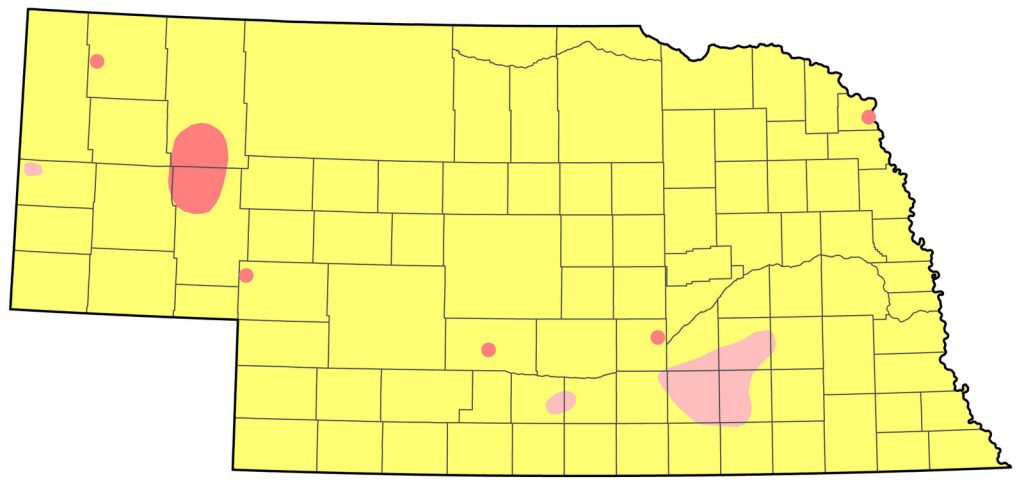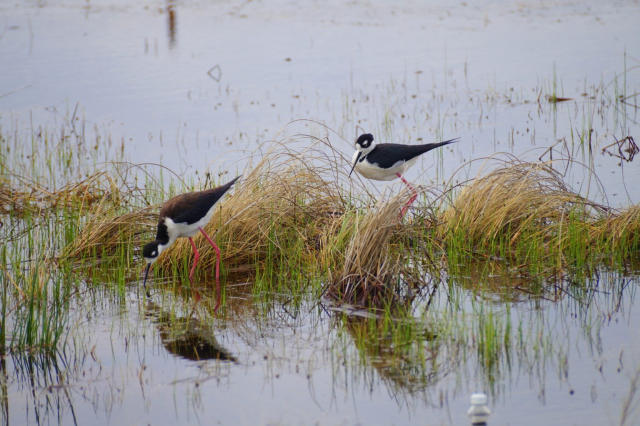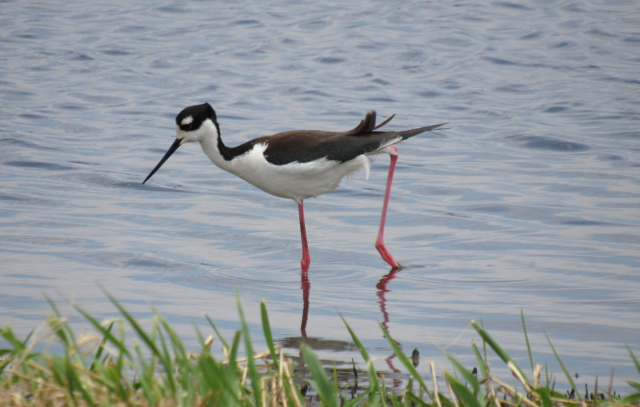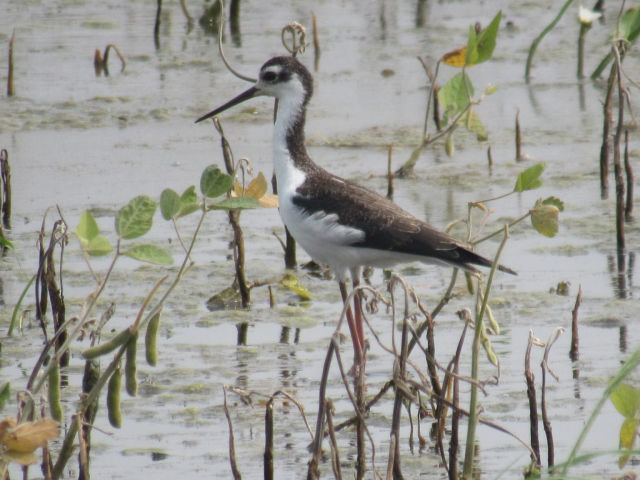Himantopus mexicanus mexicanus
Status: Increasing. Fairly common regular spring and fall migrant west and central, uncommon east. Locally uncommon regular breeder western Sandhills, rare Scotts Bluff Co and Rainwater Basin, rare casual elsewhere.

Documentation: Specimen: HMM 28534, 12 May 1956 Adams Co.
Taxonomy: AviList (2025) recognizes four species within Himantopus, one in North America, H. mexicanus, comprised of three subspecies: knudseni of the Hawaiian Islands, melanurus of southern South America, and mexicanus of North America and northern and central South America.
Nebraska birds are mexicanus.
Spring: Apr 3, 4, 4 <<<>>> summer
There is an earlier report 31 Mar 2024 Davenport, Thayer Co.
Early Jun records away from the western Sandhills are probably tardy migrants; later reports into early Jul may be of non-breeding immatures, since breeding usually occurs when birds are two years old (Robinson et al 2020).
This species is uncommon but increasingly reported in spring in the east; however, there was a nice push of 11 migrants in all at six different locations there 2-18 May 2018, followed by similar reports in subsequent years.
- High counts: 27 in Sheridan Co 7 May 1994, 23 there 20 Jul 2019, and 21 there in “spring” 1996.
Summer: Prior to 1970, this species was casual in occurrence in Nebraska with only about nine reports (Sharpe et al 2001); Swenk (1919) listed it as a “very rare migrant”. During the 1970s and early 1980s, reports increased, along with a northward expansion in the Interior from 1980-2000 (Robinson et al 2020). In Nebraska, increasing records were primarily in western areas in spring, with eight records east to Cherry, Dawson, and Lincoln Co, although there was a single eastern record in Lancaster Co 28 Apr 1981. Since 1988, Black-necked Stilts have been reported regularly.
Breeding was reported for the first time in Nebraska in 1985 when young were observed 11 Jul at two locations at Crescent Lake NWR, Garden Co (Helsinger 1985) and again in 1987 (Huber 1987). Also in 1987, Mollhoff (2022) found two nests with eggs at Lakeside, Sheridan Co 4 Jun. Nesting has continued since in Sheridan and Garden Cos, with most reports from the Lakeside area in Sheridan Co and Crescent Lake NWR. As many as six nests with eggs were found near Lakeside 16 May-6 Jun 2000 (Farrar 2001, Mollhoff 2004) and a systematic survey of lakes in Sheridan and Garden Cos specifically for Black-necked Stilts yielded observations of 28 breeding adults, 22 chicks and 35 non-breeding adults (Wells 2004). Five nests were found at Crescent Lake NWR in 2007 (Mollhoff 2008).
Nesting was not documented in Cherry Co until 2023, although a pair was seen 25 Jun 1999, another pair was photographed 2 Jul 2013, and two were a few miles south of Merritt Reservoir 5 Jun 2021. In 2023 one was photographed incubating at Valentine NWR 20 Jul, for the first Cherry Co nesting record. There is a report of a nest with eggs photographed in “northern Nebraska” in 1994 (Loren Blake, letter to NGPC Heritage Program).
In the Rainwater Basin, reports began in the late 1990s, when there were sightings at Funk WPA, Phelps Co 11 Jun 1996, 5-10 Jun 1997, and 1-3 on 11-18 Jun 2000, and 2-10 Jun 1997 in Seward Co (Jorgensen 2012). Breeding was successful at Funk WPA in 2003, when two adults with two young were seen 21 Jul-16 Aug (Drahota 2003). Nesting was reported again at Funk WPA in 2007 and 2008 (Mollhoff 2008). In 2005, multiple nests as well as several additional sightings involving more than 25 birds occurred in the eastern portion of the Rainwater Basin following heavy rains that filled wetlands, including some that were recently renovated; these were the first breeding records there (Jorgensen and Dunbar 2005). The 2005 event included nesting at Harvard WPA, Clay Co, Trumbull Basin in Clay Co, and Spikerush WMA, York Co (Jorgensen 2012). A nest with four eggs was found at Sinninger WPA, York Co 18 Jun 2016, and, based on the actions of the adults, young may have been present 9 Jul; however, the wetland was dry by 28 Jul when no stilts were observed, and the outcome of the nesting is unknown. One was on a nest in York Co 25 Jun 2021 and a pair was at Harvard WPA, Clay Co 18 Jun 2021. Breeding in the Rainwater Basin has been sporadic and usually follows heavy rainfall events, however none were observed nesting in 2015 (Jorgensen 2016).
A pair with eggs was near Crawford, Dawes Co 28 May 1994, but the outcome was not reported (Silcock and Rosche 1994). A pair of protective adults and 4-5 chicks were seen at County Road F Pond, Scotts Bluff Co, 20-22 Jul 2002, but, while the presence of avocets made the identity of the chicks uncertain, it seems likely that breeding occurred. Breeding indeed occurred in 2003, when a juvenile was seen with adults 11 Aug, and in 2004, when two pairs fledged at least one brood; incubating birds were first seen 22 May. Since then, however, this pond has been modified and stilts no longer breed there as of 2016. Among 14 stilts at Kiowa WMA, Scotts Bluff Co 11 Jul 2011 were two half-grown chicks.
Along the western Platte River Valley, nesting was noted at the Grand Island SL, Hall Co in 1998, but the outcome was not reported. Likely non-breeding immatures were 1-5 at North Platte WTP, Lincoln Co 5-20 Jun 2021. A defensive male with a fledgling 29-30 Jul 2000 at the west end of Lake McConaughy where a pair had been seen in Apr led the observer to conclude there was “no doubt nesting occurred there”; an immature was still there 11 Sep. Seven birds at Bittern’s Call WMA, Dawson Co 27 Aug 2008 included a newly-fledged juvenile likely produced there; one bird was there 12 Sep and at neighboring cattle feedlot waste-control ponds at least one nesting pair was present 2 and 5 Jul 2009.
In 2011 a surprise both by the late date and easterly location was the discovery of two nesting pairs in a flooded field in Dakota Co; two birds were seen 21 Jul and the nests were found later the same day. By 28 Jul there were nine birds in the area and incubation was ongoing 30 Jul. Of the two nests started, one had dried out and was abandoned and the other had four eggs by 2 Aug; the first downy young was seen 6 Aug and two in juvenile plumage were noted 6 Aug. Birds were still present 27 Aug, when an adult and three juveniles estimated to be 24 days old were seen.
- Breeding Phenology:
- Copulation: 14 May
Eggs: 16 May-30 Jul
Young: 24 Jun-27 Aug
Fall: summer <<<>>> Sep 1, 2, 3
Flocking and wandering begins in mid-Jul, and most depart by mid-Aug. Singles were reported in 2023 in the east in Antelope Co 22 Jun and Pierce Co 26 Jun. One was at Marsh Wren Community Wetlands, Lancaster Co 7 Jul 2025.
Later dates are 3-6 Sep 2024 Scotts Bluff WTP, Scotts Bluff Co, 8-16 Sep 2018 Sarpy Co, 9 Sep 2008 (4) Crescent Lake NWR, Garden Co, 9 Sep 2019 (2)Lake Ogallala, Keith Co, 9 Sep 2023 Crescent Lake NWR,13 Sep 2022 (2) Scotts Bluff Co, 14 Sep 2004 two Grant Co, 14 Sep 2008 Dawson Co, 16 Sep 2020 six in Clay Co, 17 Sep 2008 five at Tamora WPA, Seward Co, 21 Sep 1989 eight Lake Alice, Scotts Bluff Co, 22-29 Sep 2019 Funk WPA, Phelps Co, 1 Oct 2020 North Platte WTP, Lincoln Co, 2 Oct 2016 Sheridan Co, 1-2 Oct 2022 Lake Ogallala outlet, Keith Co, 3 Oct 2023 Lane Lake, Sheridan Co, 14 Oct 2009 Lincoln Co, and 28 Oct 2020 two over Valentine, Cherry Co.
- High counts: 43 at Funk WPA 11 Jul 2011, 39 at Crescent Lake NWR, Garden Co 18 Aug 2020, and 35 at Lakeside 31 Aug 2008.
Images
Abbreviations
HMM: Hastings Municipal Museum
NWR: National Wildlife Refuge
SL: Sewage Lagoons
WMA: Wildlife Management Area (State)
WPA: Waterfowl Production Area (Federal)
Acknowledgement
Photograph (top) of a pair of Black-necked Stilts near Antioch, Sheridan Co 20 May 2018 by Joel G. Jorgensen.
Literature Cited
AviList Core Team, 2025. AviList: The Global Avian Checklist, v2025. https://doi.org/10.2173/avilist.v2025.
Drahota, J. 2003. Breeding Black-necked Stilts at Funk Waterfowl Production Area. NBR 71: 166-167.
Farrar, J. 2001. A tale of two stilts. Nebraskaland 79: 10-19.
Helsinger, M.J. 1985. Black-necked Stilts nesting in Nebraska. NBR 53: 72.
Huber, R.R. 1987. Crescent Lake nesting records. NBR 55: 75.
Jorgensen, J.G. 2012. Birds of the Rainwater Basin, Nebraska. Nebraska Game and Parks Commission, Lincoln, Nebraska, USA.
Jorgensen, J.G. 2016. A summary of 2015 breeding bird surveys of selected Rainwater Basin wetlands. Nongame Bird Program of the Nebraska Game and Parks Commission, Lincoln, Nebraska, USA.
Jorgensen, J.G, and P. Dunbar. 2005. Multiple Black-necked Stilt nesting records in the Rainwater Basin. NBR 73: 115-118.
Mollhoff, W.J. 2004. The 2001 Nesting Report. NBR 72: 99-103.
Mollhoff, W.J. 2008. The 2007 Nebraska nest report. NBR 76: 155-165.
Mollhoff, W.J. 2022. Nest records of Nebraska birds. Nebraska Ornithologists’ Union Occasional Paper Number 9.
Robinson, J.A., J.M. Reed, J.P. Skorupa, and L.W. Oring, 2020. Black-necked Stilt (Himantopus mexicanus), version 1.0. In Birds of the World (A. F. Poole and F. B. Gill, Editors). Cornell Lab of Ornithology, Ithaca, NY, USA. https://doi.org/10.2173/bow.bknsti.01.
Sharpe, R.S., W.R. Silcock, and J.G. Jorgensen. 2001. The Birds of Nebraska, their Distribution and Temporal Occurrence. University of Nebraska Press, Lincoln, Nebraska, USA.
Silcock, W.R., and R.C. Rosche. 1994. Spring Field Report, March-May 1994. NBR 62: 66-88.
Swenk, M.H. 1919. The Birds and Mammals of Nebraska. Contributions of the Department of Entomology No. 23. Lincoln, Nebraska.
Wells, K.M. 2004. Black-necked Stilt Survey. Final Report November 2004. University of Nebraska-Omaha, Omaha, Nebraska, USA.
Recommended Citation
Silcock, W.R., and J.G. Jorgensen. 2025. Black-necked Stilt (Himantopus mexicanus). In Birds of Nebraska — Online. www.BirdsofNebraska.org
Birds of Nebraska – Online
Updated 17 Oct 2025



